service CHEVROLET ASTRO 1996 Owners Manual
[x] Cancel search | Manufacturer: CHEVROLET, Model Year: 1996, Model line: ASTRO, Model: CHEVROLET ASTRO 1996Pages: 372, PDF Size: 21.51 MB
Page 3 of 372
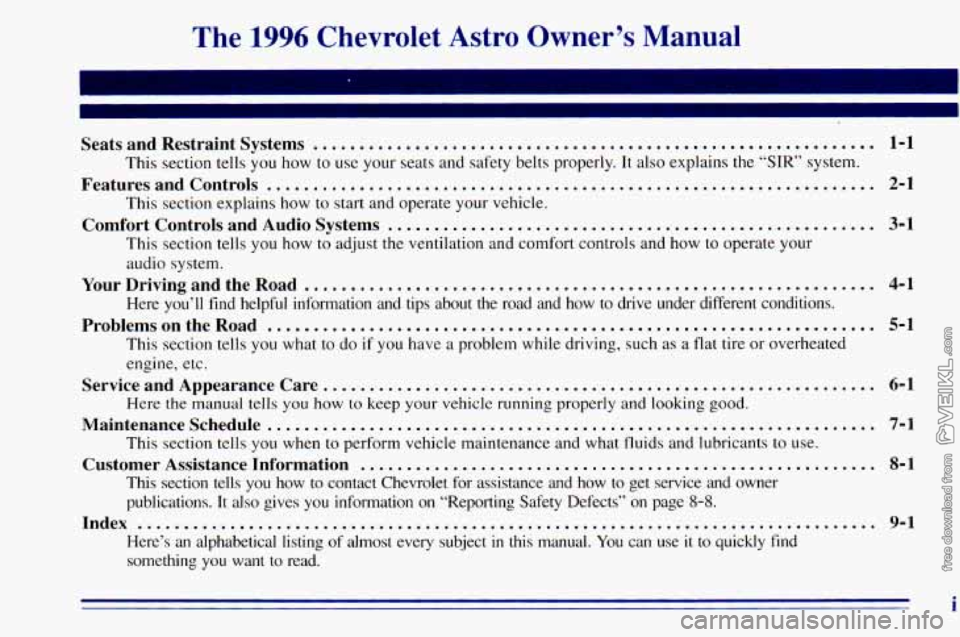
The 1996 Chevrolet Astro Owner’s Manual
Beats and Restraint Systems ............................................................. 1-1
This section tells you how to use your seats and safety belts\
properly. It also explains the “SIR” system.
Features and Controls .................................................................. 2-1
This section explains how to start and operate your vehicle.
Bmfort Controls and Audio Systems ..................................................... 3-1
This section tells you how to adjust the ventilation and comfo\
rt controls and how to operate your
audio system.
Here
you’ll find helpful information and tips about the road and how to d\
rive under different conditions.
This section tells you what to do
if you have a problem while driving, such as a flat tire or ove\
rheated
engine, etc.
Here the manual tells you how to keep your vehicle running pr\
operly and looking good.
This section tells you when to perform vehicle maintenance and \
what fluids and lubricants to use.
This section tells you how to contact Chevrolet for assistance \
and how
to get service and owner
publications.
It also gives you infomation on “Reporting Safety Defects” on page 8-8.
Here’s an alphabetical listing of almost every subject in this manual. You can use it to quickly find
something
you want to read.
YourDrivingandtheRoad .............................................................. 4-1
Problems on the Road .................................................................. 5-1
Service and Appearance Care ............................................................ 6-1
Maintenanceschedule. ................................................................. 7-1
Customer Assistance Information ........................................................ 8-1
Index ........................................................................\
........ 9-1
i
Page 4 of 372
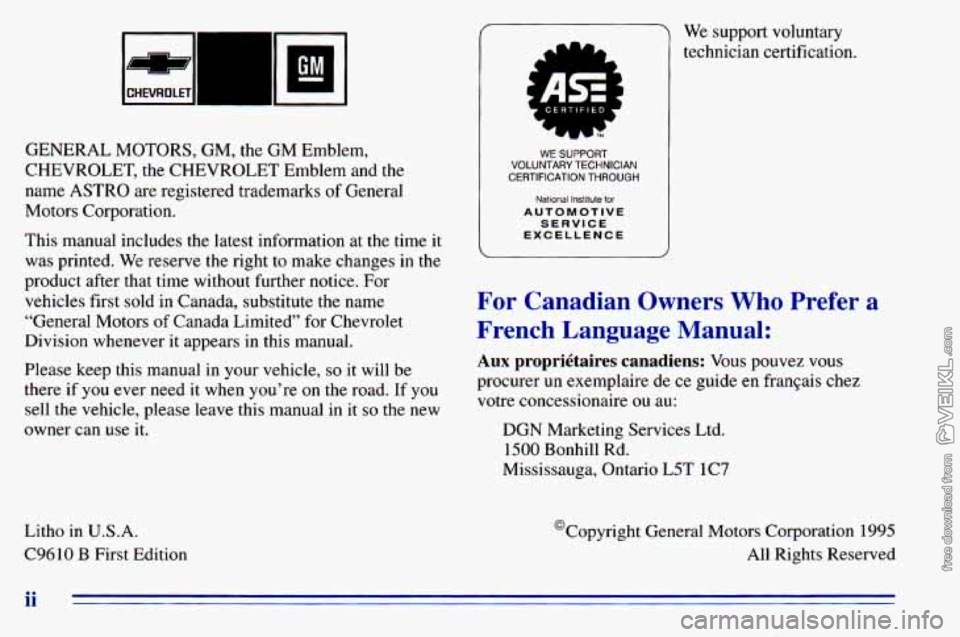
GENERAL MOTORS, GM, the GM Emblem,
CHEVROLET, the CHEVROLET Emblem and the
name ASTRO are registered trademarks of General
Motors Corporation.
This manual includes the latest information
at the time it
was printed. We reserve the right to make changes
in the
product after that time without further notice. For
vehicles first sold in Canada, substitute the name
“General Motors of Canada Limited” for Chevrolet
Division whenever
it appears in this manual.
Please keep this manual in your vehicle,
so it will be
there
if you ever need it when you’re on the road. If you
sell the vehicle, please leave this manual in
it so the new
owner can use it.
Litho in U.S.A.
C9610 B First Edition
We support voluntary
technician certification.
WE SUPPORT VOLUNTARY TECHNICIAN
CERTIFICATION THROUGH
National Institute for
AUTOMOTIVE
SERVICE
EXCELLENCE
For Canadian Owners Who Prefer a
French Language Manual:
Aux propridtaires canadiens: Vous pouvez vous
procurer
un exemplaire de ce guide en franqais chez
votre concessionaire ou au:
DGN Marketing Services Ltd.
1500 Bonhill Rd.
Mississauga, Ontario
LST IC7
@Copyright General Motors Corporation
1995
All Rights Reserved
ii
Page 36 of 372
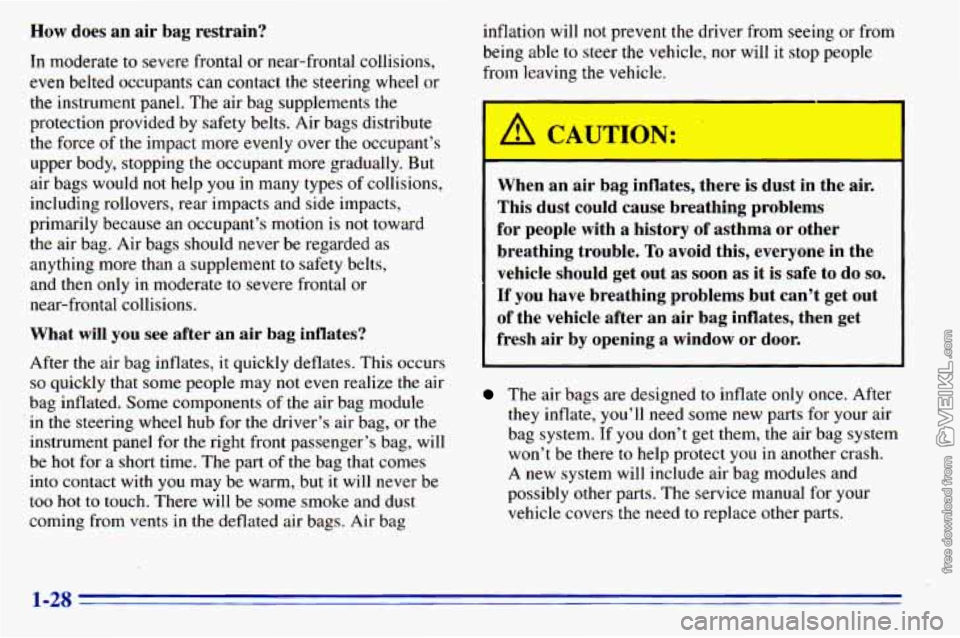
How does an air bag restrain?
In moderate to severe frontal or near-frontal collisions,
even belted occupants can contact the steering wheel or
the instrument .panel. The air bag supplements
the
protection provided by safety belts. Air bags distribute
the force
of the impact more evenly over the occupant’s
upper body, stopping the occupant more gradually. But
air bags would not help
you in many types of collisions,
including rollovers, rear impacts and side impacts,
primarily because an occupant’s motion is
not toward
the air bag. Air bags should never be regarded as
anything more than
a supplement to safety belts,
and then only in moderate to severe frontal or
near-frontal collisions.
What will you see after an air bag inflates?
After the air bag inflates, it quickly deflates. This occurs
so quickly that some people may not even realize the air
bag inflated. Some components of the air bag module
in the steering wheel hub for the driver’s air bag, or the
instrument panel for
the right front passenger’s bag, will
be hot for a short time. The part of the bag that comes
into contact with
you may be warm, but it will never be
too hot to touch. There will be some smoke and dust
coming from vents in the deflated air bags. Air bag inflation will
not prevent the
driver from seeing or from
being able
to steer the vehicle, nor will it stop people
from leaving the vehicle.
I A CAUTION:
When an air bag inflates, there is dust in the air.
This dust could cause breathing problems
for people with a history of asthma or other
breathing trouble.
To avoid this, everyone in the
vehicle should get out as soon as it is safe to do
so.
If you have breathing problems but can’t get out
of the vehicle after an air bag inflates, then get
fresh air by opening a window or door.
The air bags are designed to inflate only once. After
they inflate, you’ll need some new parts for your air
bag system. If you don’t get them, the air bag system
won’t be there to help protect you in another crash.
A new system will include air bag modules and
possibly other parts. The service manual for your
vehicle covers the need
to replace other parts.
1-28
Page 37 of 372
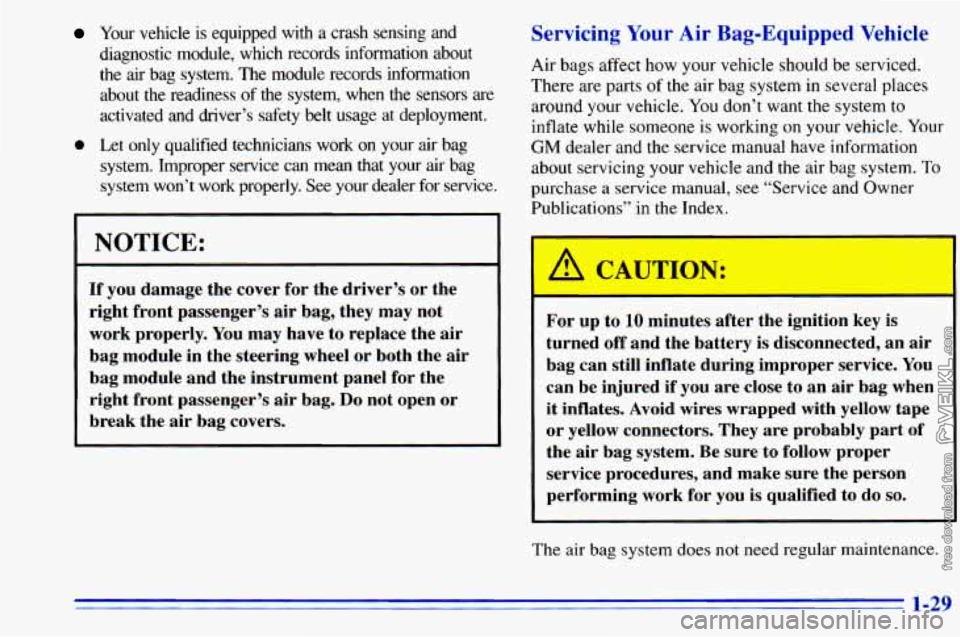
Your vehicle is equipped with a crash sensing and
diagnostic module, which records information about
the
air bag system. The module records information
about the readiness of the system, when the sensors are
activated and driver’s safety belt usage at deployment.
system. Improper service can mean that your air bag
system won’t work properly. See your dealer for service.
0 Let only qualified technicians work on your air bag
Servicing Your Air Bag-Equipped Vehicle
Air bags affect how your vehicle should be serviced.
There are parts
of the air bag system in several places
around your vehicle. You don’t want the system to
inflate while someone is working on your vehicle. Your
GM dealer and the service manual have information
about servicing your vehicle and the air bag system.
To
purchase a service manual, see “Service and Owner
Publications”
in the Index.
NOTICE:
If you damage the cover for the driver’s or the
right front passenger’s air bag, they may not
work properly. You may have to replace the air
bag module in the steering wheel or both the air
bag module and the instrument panel
for the
right front passenger’s air bag.
Do not open or
break the air bag covers.
.
For up to 10 minutes after the ignition key is
turned off and the battery is disconnected, an air
bag can still inflate during improper service. You
can be injured
if you are close to an air bag when
it inflates. Avoid wires wrapped with yellow tape
or yellow connectors. They are probably part of
the air bag system. Be sure to follow proper
service procedures, and make sure the person
performing work for you is qualified to do
so.
The air bag system does not need regular maintenance.
1-29
Page 67 of 372
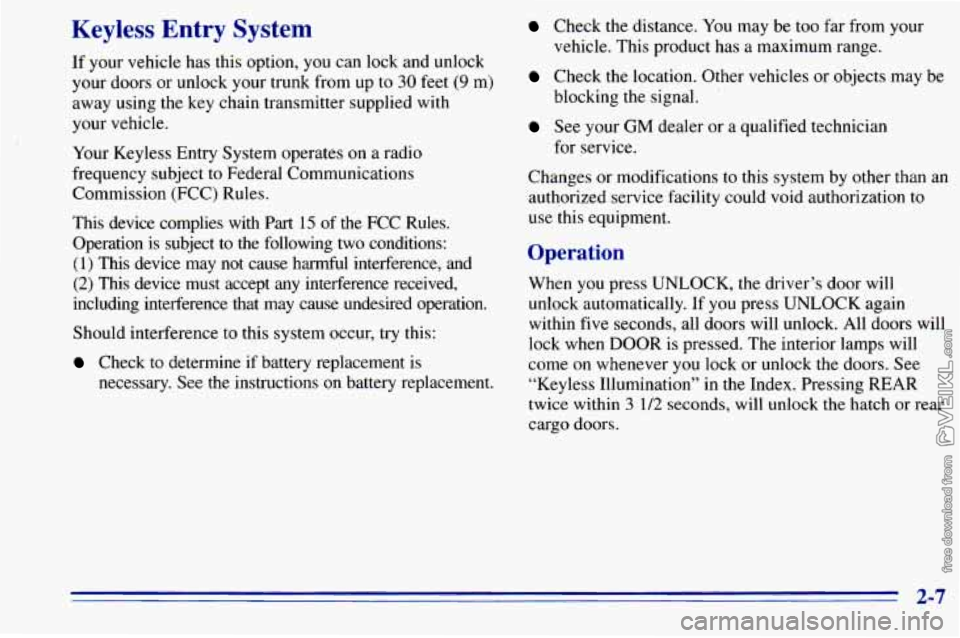
Keyless Entry System
If your vehicle has this option, you can lock and unlock
your doors or unlock your
trunk from up to 30 feet (9 m)
away using the key chain transmitter supplied
with
your vehicle.
Your Keyless Entry System operates on a radio
frequency subject to Federal Communications
Commission (FCC) Rules.
This device complies with
Part 15 of the FCC Rules.
Operation
is subject to the following two conditions:
(1) This device may not cause harmful interference, and
(2) This device must accept any interference received,
including interference that may cause undesired operation.
Should interference to this system occur, try this:
Check to determine if battery replacement is
necessary. See the instructions on battery replacement.
Check the distance. You may be too far from your
vehicle. This product has a maximum range.
Check the location. Other vehicles or objects may be
blocking the signal.
See your GM dealer or a qualified technician
for service.
Changes or modifications to this system by other than
an
authorized service facility could void authorization to
use this equipment.
Operation
When you press UNLOCK, the driver’s door will
unlock automatically. If you press UNLOCK again
within five seconds, all doors will unlock.
All doors will
lock when
DOOR is pressed. The interior lamps will
come on whenever you lock or unlock the doors. See
“Keyless Illumination’’
in the Index. Pressing REAR
twice within
3 1/2 seconds, will unlock the hatch or rear
cargo doors.
2-7
Page 75 of 372
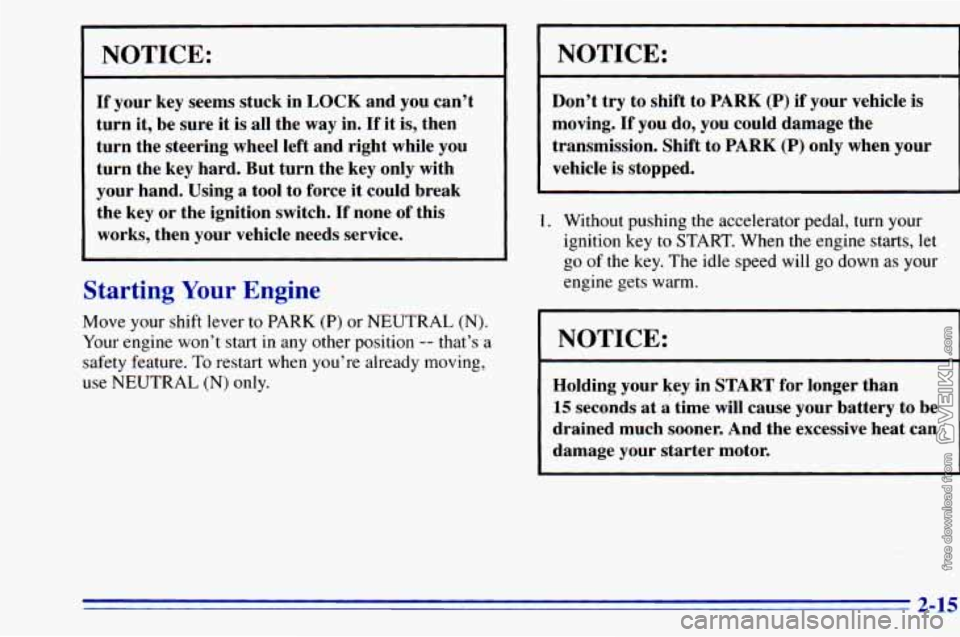
NOTICE:
If your key seems stuck in LOCK and you can’t
turn it, be sure it is all the way
in. If it is, then
turn the steering wheel left and right while you
turn the key hard. But turn the key only with
your hand. Using a tool to force it could break
the key or the ignition switch.
If none of this
works, then your vehicle needs service.
Starting Your Engine
Move your shift lever to PARK (P) or NEUTRAL (N).
Your engine won’t start
in any other position -- that’s a
safety feature.
To restart when you’re already moving,
use NEUTRAL (N) only.
NOTICE:
Don’t try to shift to PARK (P) if your vehicle is
moving. If you do, you could damage the
transmission. Shift to PARK (P) only when your
vehicle is stopped.
1. Without pushing the accelerator pedal, turn your
ignition key
to START. When the engine starts, let
go of the key. The idle speed will go down as your
engine gets warm.
I
NOTICE:
Holding your key in START for longer than
15 seconds at a time will cause your battery to be
drained much sooner. And the excessive heat can
~
damage your starter motor. ,
I
2-15
Page 114 of 372
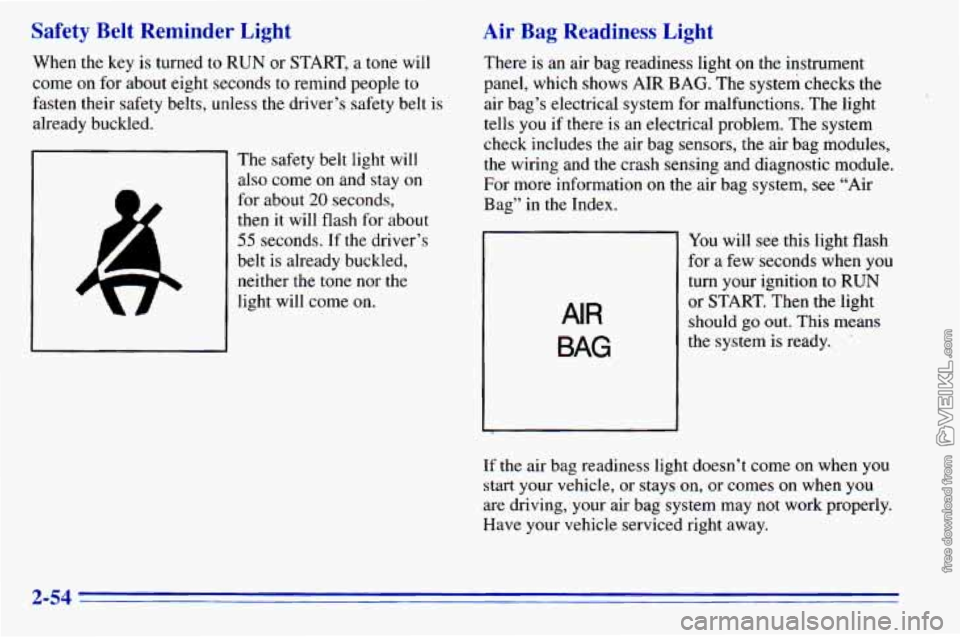
Safety Belt Reminder Light
When the key is turned to RUN or START, a tone will
come on for about eight seconds to remind people to
fasten their safety belts, unless the driver’s safety belt is
already buckled.
The safety belt light will
also come on and stay on
for about
20 seconds,
then it will flash for about
55 seconds. If the driver’s
belt is already buckled, neither the tone nor the
light will come on.
Air Bag Readiness Light
There is an air bag readiness light on the instrument
panel,
which shows AIR BAG. The system checks the
air bag’s electrical system for malfunctions. The light
tells you
if there is an electrical problem. The system
check includes the air bag sensors, the air bag modules,
the wiring and the crash sensing and diagnostic module.
For more information on the air bag system, see “Air
Bag” in the Index.
AIR
BAG
You will see this light flash
for a few seconds when you
turn your ignition to
RUN
or START. Then the light
should
go out. This means
the system is ready.
If the air bag readiness light doesn’t come on when you
start your vehicle, or stays
on, or comes on when you
are driving, your air bag system may not work properly.
Have your vehicle serviced right away.
2-54
Page 116 of 372
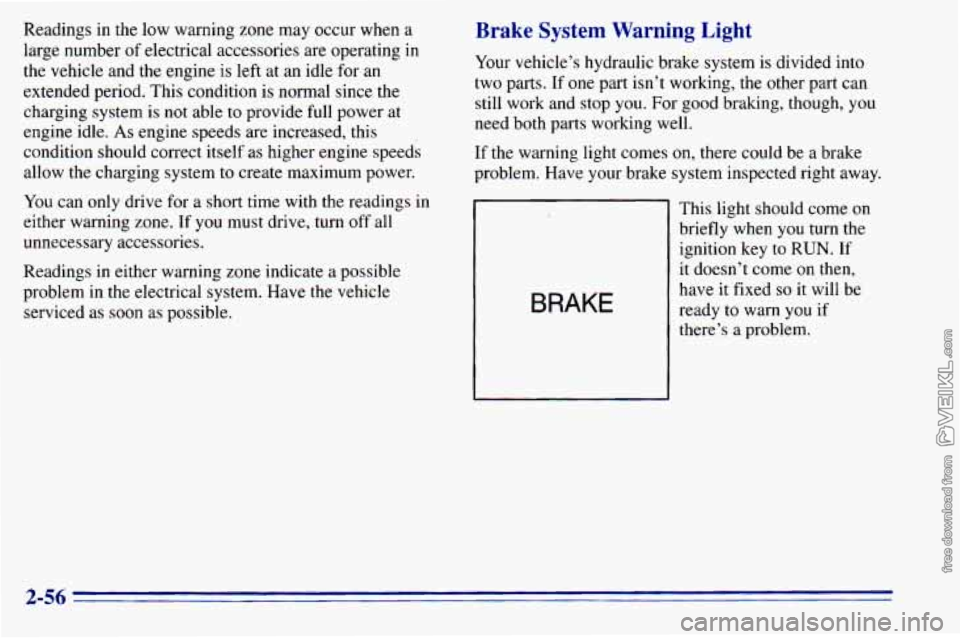
Readings in the low warning zone may occur when a
large number of electrical accessories are operating in
the vehicle and the engine
is left at an idle for an
extended period. This condition
is normal since the
charging system is not able to provide full power at
engine idle.
As engine speeds are increased, this
condition should correct itself as higher engine speeds
allow the charging system to create maximum power.
You can only drive for a short time with
the readings in
either warning zone. If you must drive, turn off all
unnecessary accessories.
Readings in either warning zone indicate a possible
problem in the electrical system. Have the vehicle
serviced as soon as possible.
Brake System Warning Light
Your vehicle’s hydraulic brake system is divided into
two parts. If one part isn’t working, the other part can
still work and stop you. For good braking, though, you
need both parts working well.
If
the warning light comes on, there could be a brake
problem. Have your brake system inspected right away.
BRAKE
This light should come on
briefly when you turn the
ignition key to
RUN. If
it doesn’t come on then,
have it fixed
so it will be
ready to warn
you if
there’s a problem.
2-56
Page 117 of 372
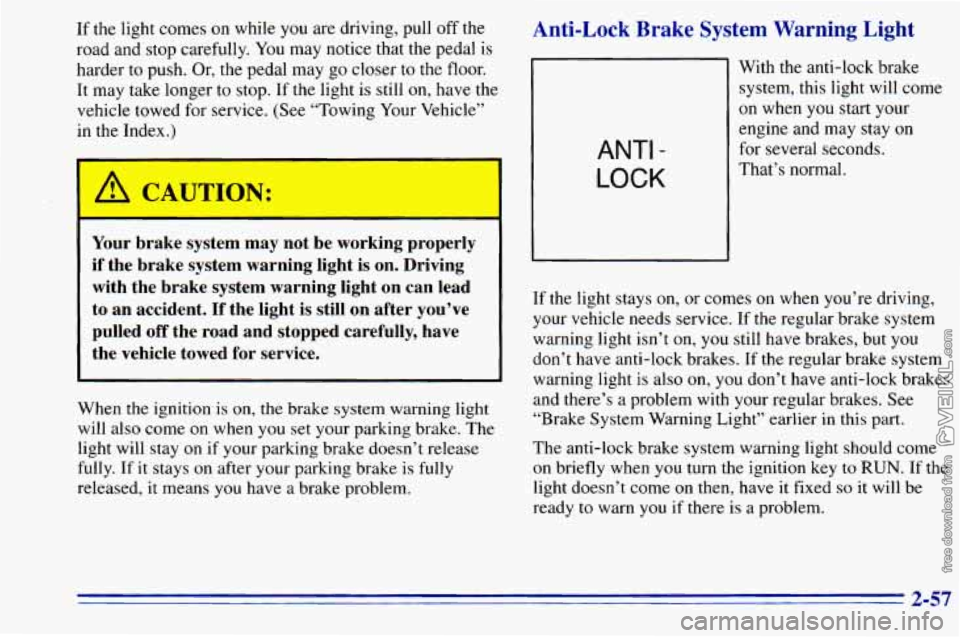
If the light comes on while you are driving, pull off the
road and stop carefully. You may notice that the pedal is
harder to push. Or, the pedal may go closer to the floor.
It may take longer to stop. If the light is still
on, have the
vehicle towed for service. (See “Towing Your Vehicle”
in the Index.)
A CAUTION:
..
Your brake system may not be working properly
if the brake system warning light is on. Driving
with the brake system warning light on can lead
to an accident.
If the light is still on after you’ve
pulled
off the road and stopped carefully, have
the vehicle towed
for service.
When the ignition is on, the brake system warning light
will also come on when
you set your parking brake. The
light will stay on if your parking brake doesn’t release
fully. If
it stays on after your parking brake is fully
released,
it means you have a brake problem.
Anti-Lock Brake System Warning Light
ANTI -
LOCK
With the anti-lock brake
system, this light will come
on when you start your
engine and may stay on
for several seconds.
That’s normal.
If the light stays
on, or comes on when you’re driving,
your vehicle needs service. If the regular brake system
warning light isn’t
on, you still have brakes, but you
don’t have anti-lock brakes. If
the regular brake system
warning light is also on, you don’t have anti-lock brakes
and there’s a problem with your regular brakes. See
“Brake System Warning Light” earlier
in this part.
The anti-lock brake system warning light should come
on briefly when you turn the ignition key to RUN. If the
light doesn’t come
on then, have it fixed so it will be
ready
to warn you if there is a problem.
2-57
Page 118 of 372

Malfunction Indicator Lamp
(Service Engine Soon Light)
SERVICE
ENGINE
SOON
Your vehicle is equipped
with a computer which
monitors operation of the
fuel, ignition and emission
control systems.
This system
is called OBD I1 (On-Board
Diagnostics-Second Generation) and is intended to
assure that emissions are at acceptable levels for the
life of the vehicle, helping to produce a cleaner
environment. (In Canada,
OBD I1 is replaced by
Enhanced Diagnostics.) The SERVICE ENGINE SOON
light comes on to indicate that there is a problem and
service is required. Malfunctions often will be indicated
by the system before any problem is apparent, which
may prevent more serious damage to your vehicle. This
system is also designed to assist your service technician
in correctly diagnosing any malfunction.
NOTICE:
If you keep driving your vehicle with this light
on, after a while, your emission controls may not
work as well, your fuel economy may not be as
good and your engine may not run as smoothly.
This could lead to costly repairs that may not be
covered by your warranty.
This light should come on, as a check to show you it is
working, when the ignition is
on and the engine is not
running. If the light doesn’t come on, have it repaired.
This light will also come
on during a malfunction in one
of two ways:
Light Flashing -- A misfire condition has been
detected.
A misfire increases vehicle emissions and
may damage the emission control system
on your
vehicle. Dealer or qualified service center diagnosis
and service is required.
0 Light On Steady -- An emission control system
malfunction has been detected on your vehicle.
Dealer or qualified service center diagnosis and
service may be required.
2-58